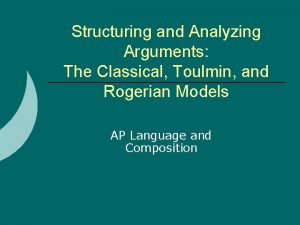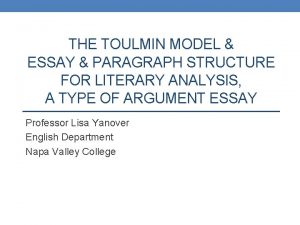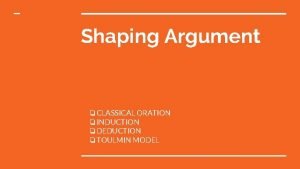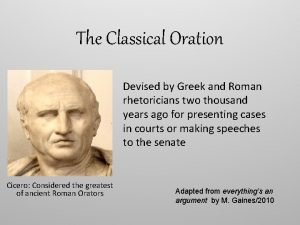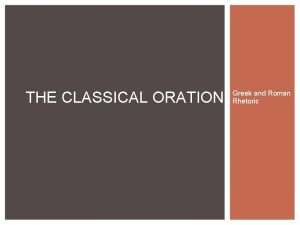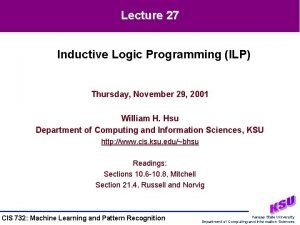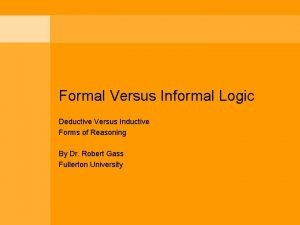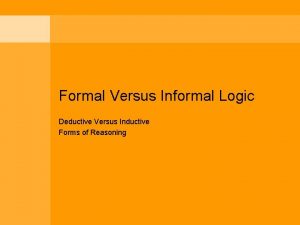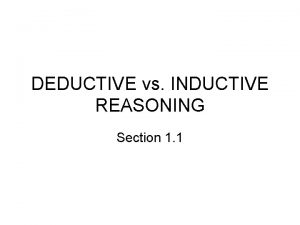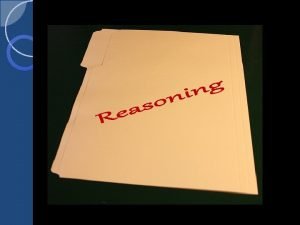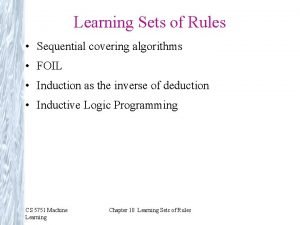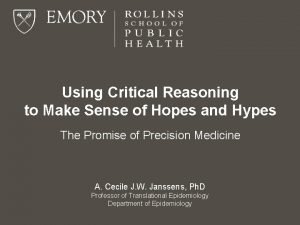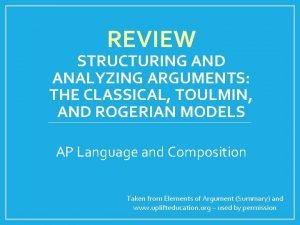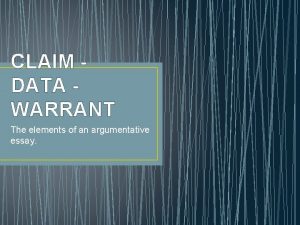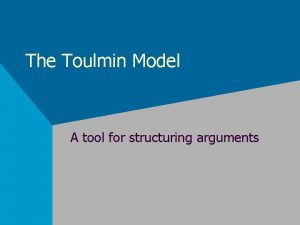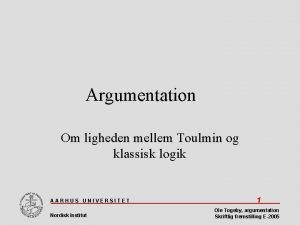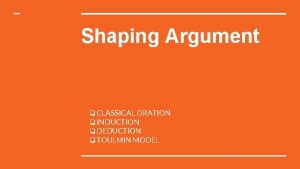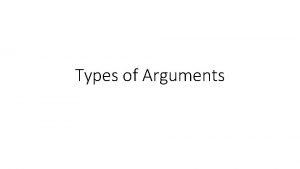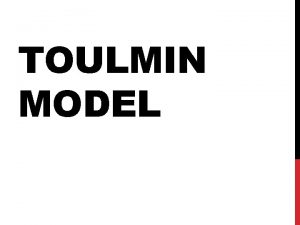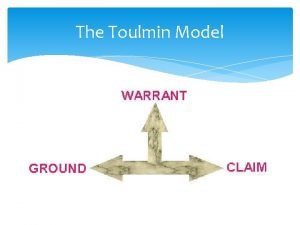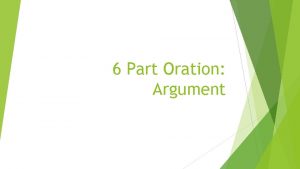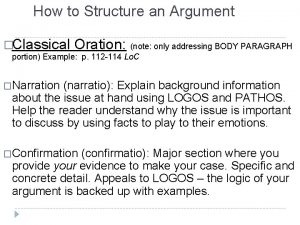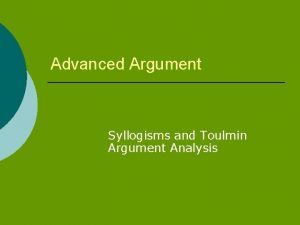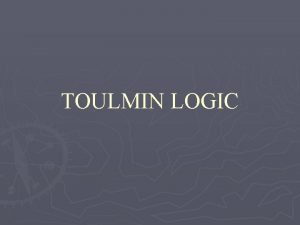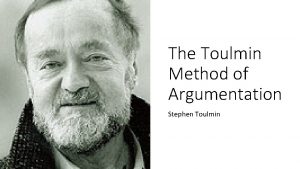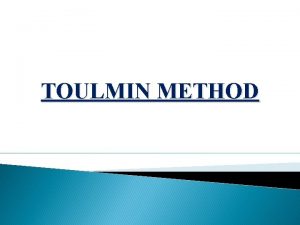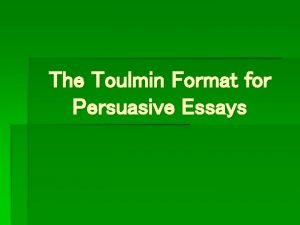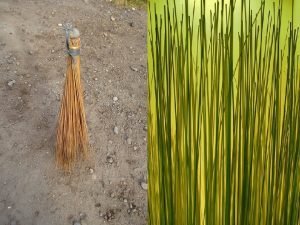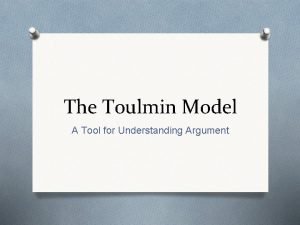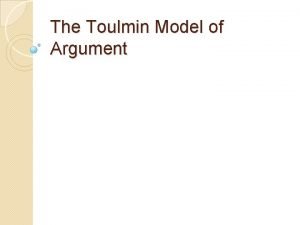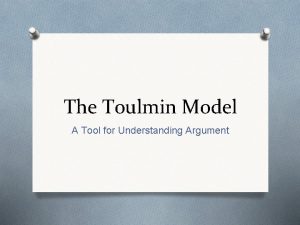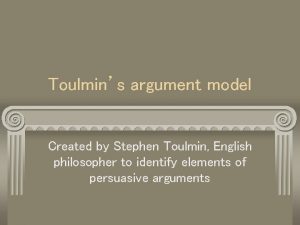Shaping Argument CLASSICAL ORATION INDUCTION DEDUCTION TOULMIN MODEL



















- Slides: 19

Shaping Argument ❏CLASSICAL ORATION ❏INDUCTION ❏DEDUCTION ❏TOULMIN MODEL

CLASSICAL ORATION Refers to the 5 part structure for an oratory, or speech that uses the following outline: 1. Introduction (exordium) 2. Narration (narratio) 3. Confirmation (confirmatio) 4. Refutation (refutatio) 5. Conclusion (peroratio)

Introduction (exordium) “Beginning the web” Introduces the reader to the subject under discussion Draws the readers into the text by piquing their interest, challenging them, or otherwise getting their attention This is where the writer typically establishes their credibility (ETHOS)

Narration (narratio) Provides factual information and background material on the subject at hand Establishes why the subject is a problem that needs addressing Often appeals to emotion (PATHOS) because the writer attempts to evoke an emotional response about the importance of the issue being discussed

Confirmation (confirmatio) The major part of the text Development or the proof needed to make the writer’s case The nuts and bolts of the essay Contains the most specific and concrete detail in the text Generally makes the strongest appeal to logic (LOGOS)

Refutation (refutatio) Addresses the counterargument The bridge between the writer’s proof and the conclusion Appeals largely to an audience’s logic (LOGOS)

Conclusion (peroratio) Brings the essay to a satisfying close Usually appeals to emotion and reminds the reader of the credibility established earlier Brings all the writer’s ideas together and answers the question, “So what? ” Remember: the last words and ideas of a text are those the audience is most likely to remember.

Practice!! Pg. 117 “Not by Math Alone” by Sandra Day O’Connor and Roy Romer Read and identify (quote/paraphrase support for this identification AND explain the effects) the different sections of the classical oration in this essay.

INDUCTION “to lead into” Arranging an argument so that it leads from particulars to universals Using specific cases to draw a conclusion Regular exercise promotes weight loss. Exercise lowers stress levels. Exercise improves mood and outlook. Exercise contributes to better health.

INDUCTION cont. Process of induction involves collecting evidence and then drawing an inference based on that evidence in order to reach a conclusion. Argument developed inductively can never be said to be true or false, right or wrong. Can only be considered strong or weak Possible vulnerability: exception to the rule These essays cannot lead to certainty, only to probability

Practice!! Pg. 121 “From Outliers” by Malcolm Gladwell

Deduction To reach a conclusion by starting with a general principle or universal truth (major premise) and applying it to a specific case (a minor premise) Often structured as a syllogism (a logical structure that uses the major premise and minor premise to reach a necessary conclusion)

Deduction (cont. ) Major Premise: Exercise contributes to better health. Major Premise: Women are poor drivers. Minor Premise: Yoga is a type of exercise. Conclusion: Yoga contributes to better health. Ellen is a woman. Conclusion: Ellen is a poor driver.

Let’s Practice!! Read “from Justice: What’s the Right Thing to Do? ” by Michael J. Sandel on pg. 125 Identify the major and minor premise and the conclusion Do the “Essay in Progress: Shaping an Argument” activity on pg. 124 Use one of thesis statements you wrote last week in your notes. The list of topics can be found on pg. 100

Toulmin Model An effective tool in uncovering the assumptions that underlie arguments 6 elements: Claim Support (evidence) Warrant (the assumption) Backing Qualifier

Toulmin Model (cont. ) Claim: conclusion whose merits we are seeking to establish Support/Evidence: duh Warrant: expresses the assumption necessarily shared by the speaker and the audience Links the claim to the evidence Backing: consists of further assurances or data without which the assumption lacks authority

Toulmin Model (cont) Qualifier: Usually, probably, maybe, in most case, most likely Tempers the claim a bit, making it less absolute Reservation: Explains the terms and conditions necessitated by the qualifier. Sometimes contains a rebuttal that gives voice to objections.

Toulmin Model (cont. ) Because (evidence as support), therefore (claim), since (assumption) , on account of (backing), unless (reservation). If there is a qualifier, it will come before the claim Example: Because it is raining, (therefore) I should probably take my umbrella, since it will keep me dry on account of its waterproof material, unless, of course, there is a hole in it.

Let’s Practice! Read “Analyzing Assumptions” pg. 127 -129 Do the “Activity” on pg. 129
 Classical argument
Classical argument Toulmin model example paragraph
Toulmin model example paragraph Classical oration structure
Classical oration structure Classical oration
Classical oration Classical oration definition
Classical oration definition Deductive method of teaching
Deductive method of teaching Induction as inverted deduction
Induction as inverted deduction Formal vs informal logic
Formal vs informal logic Induction deduction
Induction deduction Deduction vs induction
Deduction vs induction Deduction vs induction
Deduction vs induction Inductive meaning
Inductive meaning Sequential covering algorithm example
Sequential covering algorithm example Ano ang argumento
Ano ang argumento Deductive reasoning examples
Deductive reasoning examples Refutario
Refutario Rogerian vs toulmin
Rogerian vs toulmin What is the warrant of an argument
What is the warrant of an argument Toulmin model reservation
Toulmin model reservation Toulmin model
Toulmin model
